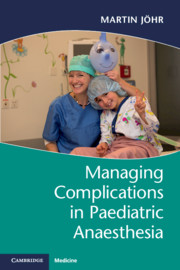Book contents
- Managing Complications in Paediatric Anaesthesia
- Managing Complications in Paediatric Anaesthesia
- Copyright page
- Dedication
- Contents
- Acknowledgements
- Abbreviations
- 1 Introduction
- 2 Concepts and Strategy
- 3 Airway-Related Problems
- 4 Vascular Access
- 5 Regional Anaesthesia
- 6 Medication-Related Problems
- 7 Pre-existing Conditions
- 8 Miscellaneous
- Index
- References
2 - Concepts and Strategy
Published online by Cambridge University Press: 09 July 2018
- Managing Complications in Paediatric Anaesthesia
- Managing Complications in Paediatric Anaesthesia
- Copyright page
- Dedication
- Contents
- Acknowledgements
- Abbreviations
- 1 Introduction
- 2 Concepts and Strategy
- 3 Airway-Related Problems
- 4 Vascular Access
- 5 Regional Anaesthesia
- 6 Medication-Related Problems
- 7 Pre-existing Conditions
- 8 Miscellaneous
- Index
- References
Summary

- Type
- Chapter
- Information
- Managing Complications in Paediatric Anaesthesia , pp. 3 - 26Publisher: Cambridge University PressPrint publication year: 2018



